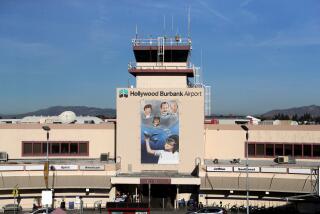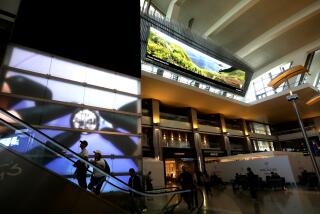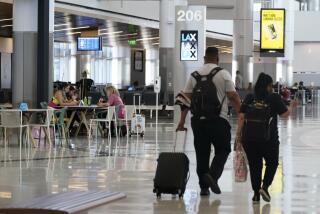Happier Landings Seen as High-Tech O’Hare Airport Terminal Opens
- Share via
CHICAGO — The Windy City is getting a new front door.
It opens a crack today when the first passengers use O’Hare International Airport’s newest and most visible addition--a huge, high-tech terminal built by United Airlines.
“We think this is the most important airline terminal in the world,” says Anthony Chaitin, United’s senior vice president for corporate services. “O’Hare is the world’s busiest airport and this will be its busiest terminal.”
The building’s unusual design is likely to make it one of Chicago’s architectural landmarks, along with the skyscraping Sears Tower, the John Hancock Building and the wedding-cake-like Wrigley Building.
40% of Passengers
When fully operational later this summer, the terminal--with 42 gates, a third of all those at O’Hare--will handle about 40% of the roughly 55 million passengers who use the airport annually. Within six years, United officials believe, the terminal could be handling 70,000 passengers a day.
American Airlines, the airport’s second major tenant with about 25% of the passenger traffic, is also in the process of rebuilding and enlarging its terminal.
The $500-million United facility--the showpiece of a $1.6-billion airport modernization--features spacious, twin barrel-vaulted glass buildings, each longer than the 103-story Sears Tower is high. The two glass pavilions, one along the airport’s entrance road and one out on the tarmac, are connected by an underground moving sidewalk 815 feet long and four lanes wide--part of more than half a mile of moving walkways in the building. The buildings are far enough apart to accommodate two lanes of moving aircraft, one of many anti-delay features built into the new terminal complex.
85-Acre Complex
When the terminal space is added to the aircraft parking ramps, the entire complex covers 85 acres--an area half the size of Chicago’s downtown Loop business district.
The 42-foot-high curved roofs use enough glass to build transparent domes over the city’s two baseball stadiums, Wrigley Field and Comiskey Park. All that glass is causing a problem because sunlight reflecting off it has been blinding some air controllers in the airport’s control tower. A wax coating has been applied to the offending panes as a temporary measure. Plans are under way to permanently resolve the problem by sandblasting or using acid to etch a rough surface onto those panels that reflect sunlight into the tower.
The perforated steel arches that support the glass panels recall an earlier era in long-distance transportation.
Recalls Railroad Era
The terminal “uses a lot of classical architectural treatments that were associated with the grand era of railroads and adapts them to the 21st Century,” Chaitin says. In scale and appearance, the terminal--designed by architect Helmut Jahn--resembles something a Hollywood special effects department might have created for a James Bond movie.
For example, the baggage sorting room--the size of a medium-sized suburban shopping mall--has seven acres of machinery and four-lane subterranean highways under the aircraft parking area between the two terminal buildings. Here, high-speed computer equipment will guide, move and sort eight pieces of luggage every second, 480 pieces a minute--691,200 pieces every 24 hours over more than seven miles of conveyor belts.
American Airlines already has a similar system operating at O’Hare. As baggage moves along the conveyors under the American terminal, red laser lights read the destination codes labeled to each piece. That tells one of scores of mechanical pusher-paddles along the conveyor routes when to shove a bag onto another conveyor, until it ends up--presumably--on the same plane as its owner.
Improvement Planned
United eventually plans to encode not only the passengers’ destinations, but also their names and addresses on each bag and expects the equipment to be able to monitor where each bag is throughout the sorting and loading cycle.
Although passengers will never see the baggage system, they will see the automated ticket takers United plans to install at each boarding gate. These machines will replace the gate agents that now take tickets from boarding passengers.
And American Airlines expects soon to have automatic machines doling out boarding passes and assigning seats.
Another system United passengers will never see is an elaborate network of pneumatic tubes and conveyors set up to move repair parts from a central storage spot to one of eight repair stations throughout the aircraft parking areas. This will reduce gate delays, airline officials predict.
A high-speed tramway to move passengers between terminals, enlarged roadways in front of terminal buildings and a new international terminal are also planned at O’Hare.
More to Read
Sign up for Essential California
The most important California stories and recommendations in your inbox every morning.
You may occasionally receive promotional content from the Los Angeles Times.










